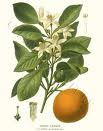May 2, 2010
Essential Oil Focus: Sweet Orange (Cintrus sinensis)
Sweet Orange – Ease, Adaptability, Optimism*
Cold-pressed from the rind of the fruit Citrus sinensis, Sweet Orange essential oil has a warm, fresh, delicious aroma that, not surprisingly, smells just like ripe, sweet oranges! Yum.
Like other citruses, Sweet Orange is a circulatory and digestive stimulant, promoting the flow of lymph and bile. The essential oil can be used topically in massage (diluted 1:5 with a carrier oil) on swollen areas, or over the stomach for digestion.
As a direct inhalation, or diffused through the room, Sweet Orange is relaxing and antidepressant. Energetically, Sweet Orange is useful for people who are “Type A”, overly committed, perfectionists, or who tend to take things too seriously. Sweet Orange encourages skillful adaptability and optimism.
The Chinese regard the Orange as a good luck symbol and often emply the bitter orange (Bergamot) as a digestive tonic and antispasmotic. The sweet orange is considered a Qi-tonic, removing blockages in the energy meridians. In Ayurveda, the sweet orange is also used to stimulate digestion, especially in for Vata and Kapha imbalances. Those with Pitta imbalances in need of digestive support are better served by Peppermint EO.
Sweet orange is Generally Regarded as Safe (GRAS), is generally non-irritating, and unlike other citrus eo’s, not photo-toxic. It can be used in diffusers, steam inhalation, massage, compress, bath, and skin care.
Combined with Lavender, it is a great relaxant before bed. Combined with Cardamom it is a perfect digestive for people with sluggish digestion or nausea after a heavy meal.
*From Gabriel Mojay’s Aromatherapy for Healing the Spirit
Other reference: The Complete Guide to Aromatherapy, by Salvatore Battaglia
March 13, 2010
Staying Healthy for Spring
Seasonal transitions are a common time for health imbalances to arise. According to the holistic eastern medicine practices, now is the time to clear out the build-up of winter to make room for the upward rising energy that comes with springtime. If we don’t, we will commonly experience grogginess, headaches, digestive difficulties, increased susceptibility to colds, and the onset of seasonal allergies. Below are some suggestions how to go about this using diet, yoga, and essential oils to stay healthy with the season.
 Diet – Lightening Up
Diet – Lightening Up
In general late winter/early spring is a good time to abstain from the heavier foods and feasting of the winter season and favor lighter seasonal foods that are easy to digest and have plenty of fiber. It is an excellent time of year to undertake a mild nutritive cleanse like having only vegetable soup and herbal teas for a couple of days. Limiting the intake of certain foods can help your digestive system rest, therefore boosting your natural immune defenses (did you know over 60% of your immune system is in your gut?!).
If you are especially prone to colds and allergies, limit or eliminate dairy, caffeine and alcohol for 2-6 weeks. If you have severe seasonal allergies elimination of these items is doubly important because in most individuals these substances increase the inflammatory response of the immune system. Allergy sufferers should also stay away from eating melons since they can initiate this histamine response. If you get allergies, you can benefit from starting to drink 1-3 cups of nettles tea daily with a small amount of raw local honey before the allergy season hits full force, and throughout allergy season.
Yoga – Cleansing
The ancient yogic practice of cleansing the sinuses with a neti pot can be indispensable for cold and allergy sufferers. It can be both a preventative and medicinal tool. Cleansing the sinuses calms inflammation of the nasal passages and kills bacteria and viruses that might be lingering. After cleansing with the neti pot be sure to lubricate the inside of the nasal passages by gently applying a small amount of raw, organic olive or sesame oil to a cotton swab and moistening the inside of the nostrils. This will prevent irritation of the newly cleansed mucous membranes.
Yoga postures that focus on cleansing such as spinal twists and forward bends will help clear toxins and build-up from the organs and digestive system, and clear mental cloudiness. Adding more of these poses to your practice as well as breathing practices such as bhastrika (bellows) can boost the metabolism and the immune system.
Celebrate Spring in Good Company!
Come to my “Growth & Renewal” Mini-Retreat on Sunday, April 18th to experience the rejuvenation that comes from a complete yoga practice.
Essential Oils – Build Your Immunity
Essential oils have powerful antibacterial, antiviral, and anti-inflammatory properties. Using essential oils daily either by inhalation, or topically can keep you cold and allergy free. Lavender, Rosemary, Yarrow, Peppermint and Eucalyptus essential oils are all extremely useful for preventing and treating symptoms of colds and allergies. (Caution: individuals with epilepsy or asthma should avoid rosemary essential oil). If you happen to already be experiencing a cold or allergies these same essential oils can boost your immune system, and clear congestion from the lungs and sinuses. For respiratory conditions, direct or diffuse inhalation is very effective. But, these oils can also be applied directly to the skin (always dilute peppermint with carrier oil), and/or used in the bath.
Of Course….
As always, the common sense practices of plenty of rest, exercise, sunshine, fresh food and water, and washing your hands will help keep your body at it’s peak of health and resistance to imbalances.
January 8, 2010
Neti Worth: Stock in the value of nasal irrigation is up
 Just found this great article at Well & Good on using the Neti Pot. Neti Worth: Stock in the value of nasal irrigation is up «
Just found this great article at Well & Good on using the Neti Pot. Neti Worth: Stock in the value of nasal irrigation is up «
If you’ve never tried, it really is a fantastic help for sinus-related problems, and for fending off colds. I’ve never managed to do it daily, which I’d like to work up to. But, I do use it when I have hay-fever, respiratory cold, or sinus infection to enormous benefit. If only I could convince my 9-year old to try!
I have a couple items to add to the conversation. Firstly, it is very beneficial to follow your neti by lubricating the nasal passages with Sesame Oil (raw, organic, cold-pressed). After completing the neti, apply a small amount of sesame oil with your finger or cotton swab inside the nostrils. This will help keep them lubricated and enhance their filtering power. Think of it like this: you always moisturize your face after washing, right? Same here.
The article mentions doing a steam with Eucalyptus which is also a great way to clear sinuses. If you do both neti and steam, do neti first. Eucalyptus essential oil is extremely antibacterial and it’s pungent vapors are also anti-inflammatory so it will clear your sinuses and fight infection at the same time.
There are many varieties of Eucalyptus – Eucalyptus globulus is the most common, but the Eucalyptus Radiata is my favorite since it has a great lemony sweet aspect (not as harsh as globulus) and is very safe for children. I get mine through YoungLiving Essential Oils. Other excellent essential oils to combat sinus infections are Sweet Marjoram (Origanum marjorana), Ravensara (Ravensara aromatica), and Bay (Lauris nobilis). Inhale straight from the bottle, add them to your steam, add a couple drops to your diffuser, or add to massage oil and rub into feet, chest and throat.
Here’s to breathing free!
(full disclosure: I am a distributor of YoungLiving Essential Oils and the link is to my affiliated site – they are the only source I have found for that particular variety of Eucalyptus)
January 2, 2010
Essential Oil Teething Remedy
 OK mommies and daddies – a lot of you have teething babies at home. Here’s a remedy for you. Well, for your baby.
OK mommies and daddies – a lot of you have teething babies at home. Here’s a remedy for you. Well, for your baby.
Clove Bud Essential Oil (Syzygium aromaticum) has anesthetic properties and is used by dentists to numb the gums before administering shots. It’s surprisingly numbing. Adults can try a drop on a finger or cotton swab directly on their own gums to feel the effect. For teething babies the essential oil needs to be diluted in a carrier oil. Pretty much any nice organic vegetable or nut oil will do (olive, almond, grapeseed, jojoba…). Read the bottom 0f the post for suggestions on where to get good, therapeutic-grade essential oils.
In a nice clean (small) bottle or jar:
2 drops Clove Bud essential oil
1 teaspoon carrier oil
(store in a cool place, not exposed to direct sunlight)
Test a bit on your own gums and tongue so you make sure it’s a delicate effect. My baby absolutely loves this remedy and shows it by eagerly opening is mouth for my finger when he sees me getting the bottle. I just dip the tip of my finger in the bottle and rub the mixture all over his gums. You could also use a cotton swab instead of your finger. I don’t suggest adding the mixture to the surface of teething toys since it could easily make it’s way into baby’s eyes and be very irritating.
If for any reason your baby has a strong adverse reaction to this remedy, immediately apply some of your plain carrier oil to the gums. This will immediately dilute the blend and restore comfort. This goes for any essential oil that might accidently get into your eye – immediately wash area with plain carrier oil.
Sourcing therapeutic-grade essential oils:
If you are in the vicinity of a good health-food store, most will have a decent selection of medicinal quality essential oils. Good common brands are Aura Cacia, Floracopeia, and Wyndemere. If you would like to order through me online, you can visit my YoungLiving Essential Oils affiliated website http://www.youngliving.org/nicoleb
Stay tuned for how to use the rest fo that bottle of Clove Essential Oil after the teething days are gone. If you have any questions about this or other essential oil/aromatherapy needs, feel free to contact me by email or in comments. nicole “at” anamiyoga “dot” com
December 15, 2009
Good and Sticky: How to clean your yoga mat
It’s not often that Sticky means Clean. Except in the case of your yoga mat. Either you’ve been using it forever and it’s dirty and the stick is gone or, it’s brand new out of the package and slippery. Either way, the solution is to Wash It!
Either by hand in your bathtub, or on Delicate setting in the washing machine. ONLY A LITTLE SOAP. Hang dry. Putting it in the dryer will cause a strange burning plastic smell to permeate your entire house and you will end up with not just a sticky, but positively GOOEY mat (and dryer). Trust me, I learned the hard way. If you do put it in the dryer, use that AIR setting which is NO HEAT.
Voila! Clean and Sticky Mat. The way it should be!
Depending on how often you use your mat, and how quickly it becomes dirty – like if you’re doing a lot of hot yoga, wash your mat once a month or every few months. In the mean time you can surface clean it with a little homemade spray. Put 10 drops each of lavender and tea tree essential oils in a spray bottle with water (and sometimes a tbs of vinegar too) and spritz on your mat, wipe dry. Lavender and tea tree both have antibacterial and deodorizing properties and will leave your mat disinfected and smelling so fresh and so clean!
